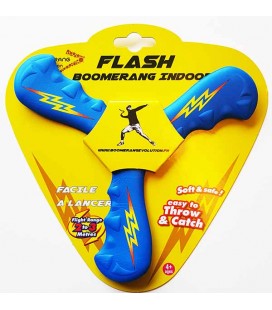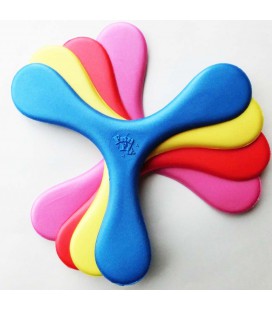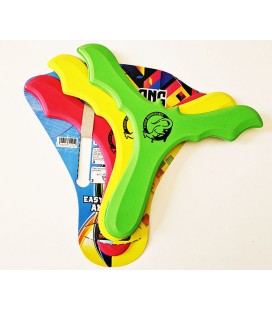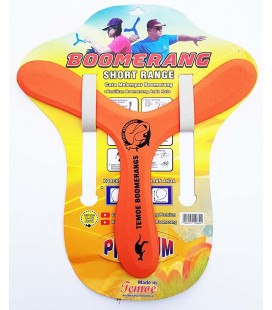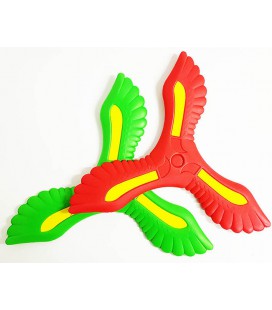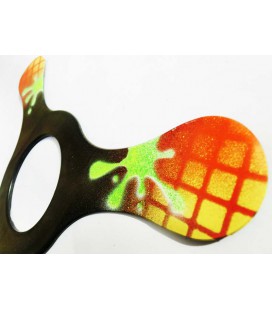Panier 0
0 item(s) - 0,00 € Pas de produit
To be determined Frais de port
0,00 € Total
Quantité
Total
Produit ajouter avec succès
Il y a 0 éléments dans le panier Il y a 0 éléments dans le panier
Total
Catalogue
Boomerang enfant
Les boomerangs présentés sur cette page sont particulièrement adaptés pour les enfants.
Cependant, ces boomerangs peuvent tout à fait être lancés par des adultes sans difficulté.
Quelles sont les particularités d'un boomerang pour enfant ?
Un enfant peut lancer un boomerang dès 4 ans, cela peut sembler surprenant mais c'est possible puisqu'i...
FLASH indoor
4,90 € En stockboomerang d'intérieur exceptionnel : Le FLASH se lance dès 4 ans, léger et inoffensif, il se lance uniquement en intérieur, en bleu ou en jaune avec un packaging au top. Une finition et une déco sans bavure. PETIT CONSEIL : donnez une légère incidence pour réduire légèrement sa portée et surtout visualisez nos VIDEOS ci dessous.FLAT LOOP
4,90 € En stockLe Room loop s'appelle désormais le FLATLOOP, est tout simplement FABULEUX! C'est notre BEST-SELLER!Il s'agit du tout premier boomerang d'intérieur profilé.En mousse, incassable et inoffensif, le Room loop permet de s'initier au boomerang en toute sécurité tout en s'amusant.Il s'agit d'un véritable boomerang déjà profilé avec son bord d'attaque et son...Mac Squeezy
5,90 € En rupture de stockEn rupture de stockUn excellent petit boomerang en mousse, inofenssif, très performant profilé droitier, au couleur sympa. une finition au top avec des instructions imprimées au dos du boomerang. une portée de 5m. Inutile de le régler, vous le déballez et il vole parfaitement avec un retour devant vous et une descente parfaite hélicoptère.Fun fly
5,90 € En stockIl s'agit là du tout premier boomerang en mousse d'intérieur. Un boomerang ambidextre d'une portée de 1 à 3 mètres, qu'il vous faudra régler en droitier ou en gaucher en lui donnant diedre et incidence. Sur le model du trifly, c'est un incontournable. retour hélicoptère parfait.boomerang flipfly
5,90 € En stockLe boomerang Flipfly est un boom en mousse d'intérieur ambidextre crée par Eric Darnel. C'est le petit fère du Funfly. Plus petit, il est plus rigide et plus nerveux, il va plus vite. portée de 2 à 3m maxi à lancer depuis son canapé, plaisir assuré.Quadrirang
5,90 € En stockQuadrirang est un boomerang quadripale pour l'intérieur, une mousse de qualité, idéal pour s'amuser à la maison, une portée de 2 à 4m selon réglages. ce boom est très facile, c'est pour moi l' un des meilleurs booms indoor. une déco avec des lions. permet d'apprendre à lancer dès 5 ans.Beach Loop
6,90 € En rupture de stockEn rupture de stockLe BEACH LOOP est le grand frère du ROOM LOOP, il ne faut pas les confondre car ils ont la même forme mais ne sont pas constitués de la même mousse.D'une portée d'environ 5 mètres, je l'utilise lors de mes initiations avec les plus jeunes. Ils l'adorent !!!Dès 5 ans il permet de progresser vers un boomerang plus rigide.C'est la liaison entre un boomerang...SUNFLY
7,20 € En stockLe Sunfly est LE boomerang débutant par excellence.S’il il y a bien un boomerang à posséder pour le plaisir, pour l’échauffement, pour initier les plus jeunes : c’est CELUI LA !!! Son large trou central facilite énormément les rattrapages sur un doigt. On ne peut pas faire plus facile !!!! Boomerang droitier.aqueena short range
7,90 € En stockAqueena short range est un des rare quadripale en mousse pour l'extérieur, très stable par vent calme il convient aux adultes et aux enfants dès 6 ans. Une trajectoire basse et circulaire, il sera très précis en le réglant un peu. portée de 10 mètres maxBirdy boom
7,90 € En stockUn boomerang en forme d'oiseau, quoi de plus original ? le Bidy boom est très coloré c'est un boom soft inofenssif d'une portée de 10 mètres environ. Un léger dièdre et une petite incidence pour optimiser son vol. Il peut voler en exterieur sans vent ou en indoor dans une grande salle. Dès 6 ans.BATRANG
7,90 € En stockUn Bat boomerang en mousse et en bipale cette fois. Au TOP dans les petits jardins, completement inofenssif, une portée de 10 mètres max, il necessitera un léger dièrdre et une petite incidence pour optimiser le vol. A utiliser sans vent. Il se lance comme tous les boomerangs c'est a dire presque vertical. Vous aurez l'impréssion d'être un super HERO !!...tribat
7,90 € En stockun BATBOOM façon tripale, très léger, en mousse, d'une portée de 5 mètres maximum, il vole parfaitement mais uniquement sans vent ou en indoor. Il nécessite un léger dièdre positif et une petite incidence pour optimiser son vol. Dès 5 ansShort range
7,90 € En stockShort range est un boomerang de chez temoe dont la forme est inspirée des boomerangs de vitesse, une légère incidence et vous obtenez un boomerang très précis mais sans vent, sans danger dès 6 ans il a une portée de 10 mètres max.compas short range
7,90 € En stockoriginal le "compas" est un formidable petit boom en mousse avec des pales légèrement différente, une portée de 5 à 7 mètres max, idéal pour les petits espaces mais sans vent ! vous pouvez le rattraper sur un doigt, il est très tolérent, donnez lui un petit dièdre pour débuter. dès 6 ans inoffenssif.ice runner short range
7,90 € En stockLe Ice runner short range est inspiré d’un célèbre boomerang de vitesse dessiné par Fridolin Frost. Une trajectoire rapide et rasante à utiliser sans vent, il est ultra précis, portée d’environ 10 mètres. Dès 6 ans. Avoir des notions de réglages est un plus.boom range
7,90 € En stockun boomerang traditionnel en mousse, il fallait y penser et à ma grande surprise ca fonctionne du tonnerre, un vrai vole de bipale à 10 m maxi, à utiliser sans vent, mais franchement que du bonheur, coloris variés, donnez juste un petit diedre positif et c'est parti pour le funXoomarang
7,90 € En stockXoomarang est un petit boomerang en mousse qui vole sans vent, une courte portée de 5 à 7m. 4 couleurs dispo, rouge, bleu, jaune ou vert. Idéal pendant les soirées d'été sans vent ou en salle de sport. Dès le plus jeune age, inoffensif, une bonne finitionplumarang
7,90 € En stockPlumarang est un boomerang original formé de 3 plumes, une trajectoire rasante, il nécessite un bon coup de poignet. Idéal sans vent, une portée de 8 à 10 mètres, excellent pour les petit espaces ou en salle de sport. inoffensif à la portée des plus jeunes.Agile
7,90 € En stockUn petit boomerang coloré pour droitier d'une portée de 6m, à la fois ludique et éfficace. C'est un boom qui se lance partout. très facile, les enfants apprecieront son retour et sa legerté. Très fin, il ne fait que 2mm d'épaisseur. A lancer dès 5 ans, sans vent. Regardez les nombreuses videos!!Shuriken
8,90 € En stockun boomerang à la forme originale dessiné par jerri leu et seb guiheux, la version polypro est idéale pour les débutants une portée de 18 m.très ergonomique, des trous en bout de pales. l'un de nos meilleurs boom. déco flamme pour cette versionboomerang Sunfly black édition
9,00 € En stockLe boomerang SUNFLY BLACK EDITION est une nouvelle version de notre désormais célèbre boomerang débutant. Plus lourd, plus dense, il s'adresse à ceux qui souhaitent un boom d'une portée d'environ 25m contre 18m pour la version polypro. Il nécessite un lancé un peu plus fort mais reste toujours aussi facile. Votre défi le rattrapper sur un doigt....Pegasus
9,90 € En stockUn nouveau boomerang bipale en polypropylène injecté, il est très fermé et donc facile à rattrapper. C'est un boomerang allemand de la marque "Gunther" très éfficace et très ludique. Une portée d'environ 20 mètres. C'est pour moi l'un des boomerangs bipale plastique les plus facile, d'un excellent rapport qualité/prix.Spiroboom
9,90 € En stockUn boomerang incroyable en forme de spirale, un effet visuel hallucinant. J'ai beaucoup travaillé sur ce shape pour vous offrir une véritable innovation. désormais en polypro pour un prix plus abordable,, très facile à lancer, portée 18m dès 12 ans.Boomerang lumineux Sunfly
9,90 € En stockUne version lumineuse et phospho de notre célèbre boomerang SUNFLY. Pur réaliser de fabuleux lancé de nuit, vous serez bluffé par la luminosité de ce boomerang. Il garde les même caractéristiques que le SUNFLY polypro. Des paillettes sont intégrées au boom ce qui donne un côté "boule à facette".Un boom toujours aussi facile et agréable. visionnez les...

